Abstract
1. In hypothyroid rats, we determined the effects of administration of different doses of 3,3',5-triiodo-L-thyronine (T3), 3,3'-diiodo-L-thyronine (3,3'-T2) and 3,5-diiodo-L-thyronine (3,5-T2) ("T2 isomers' refers specifically to these latter two isomers throughout this paper) on resting metabolism (RM) and on the oxidative capacity (measured as cytochrome oxidase activity) of tissues that are metabolically very active. 2. The T2 isomers induced a dose-dependent calorigenic effect when injected I.P. into hypothyroid rats. The increase in RM was already evident at a dose of 2.5 micrograms (100 g body wt)(-1), and the greatest effect was observed at the highest dose, 10 micrograms (100 g body wt)(-1), when RM reached a value not significantly different from that of the euthyroid controls (1.92 +/- 0.08 and 1.93 +/- 0.13 (1 O2) kg(-1) h(-1) for 3,5'-T2, respectively, vs. 2.1 +/- 0.12 (1 O2) kg(-1) h(-1) for euthyroid controls). T3 administration restored RM to normal euthyroid values, even at a dose of 2.5 micrograms (100 g body wt)(-1). 3. The effect of T2 isomers on RM was paralleled by an increase in the oxidative capacity of tissues that are metabolically very active (liver, skeletal muscle, brown adipose tissue (BAT) and heart). The increases were between 33% (liver + 3,3'-T2) and 63% (muscle + 3,3'-T2). By contrast, T3 induced its greatest effect on the liver, with a smaller effect on skeletal muscle, but no significant stimulation in heart and BAT, whatever the dose. 4. These results suggest that T8 isomers might be mediators of the direct thyroid hormone regulation of energy metabolism.
Full text
PDF
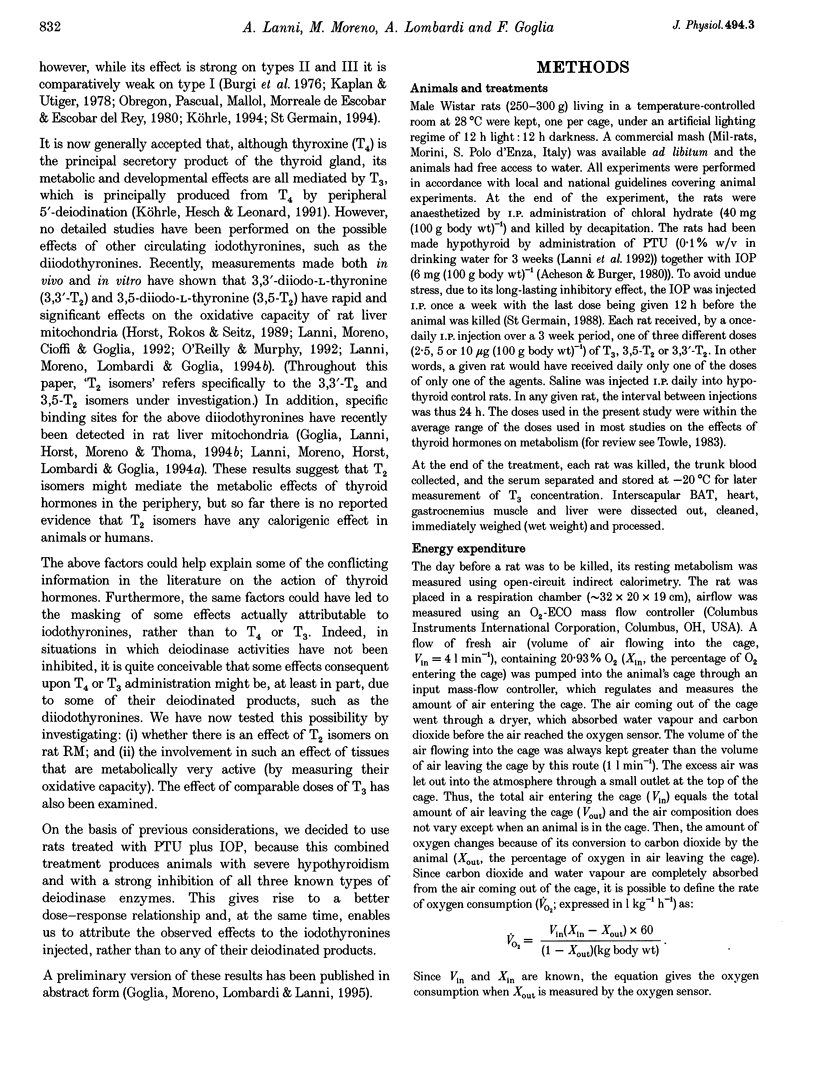
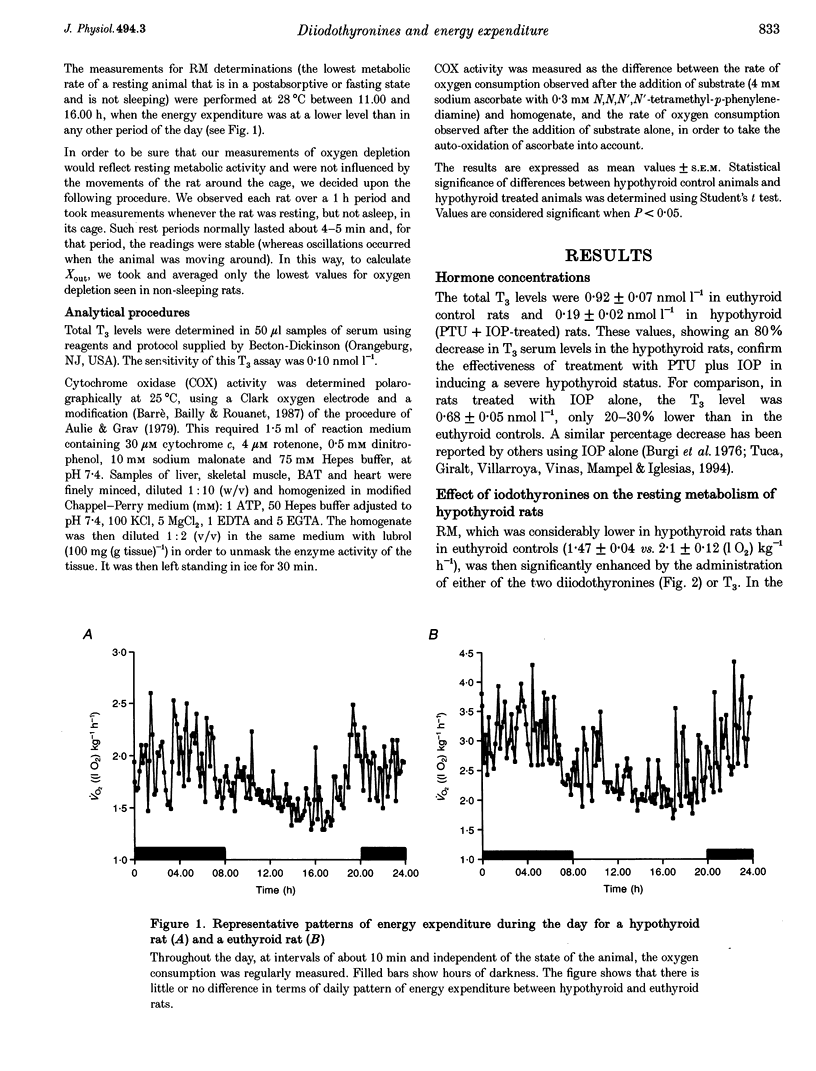
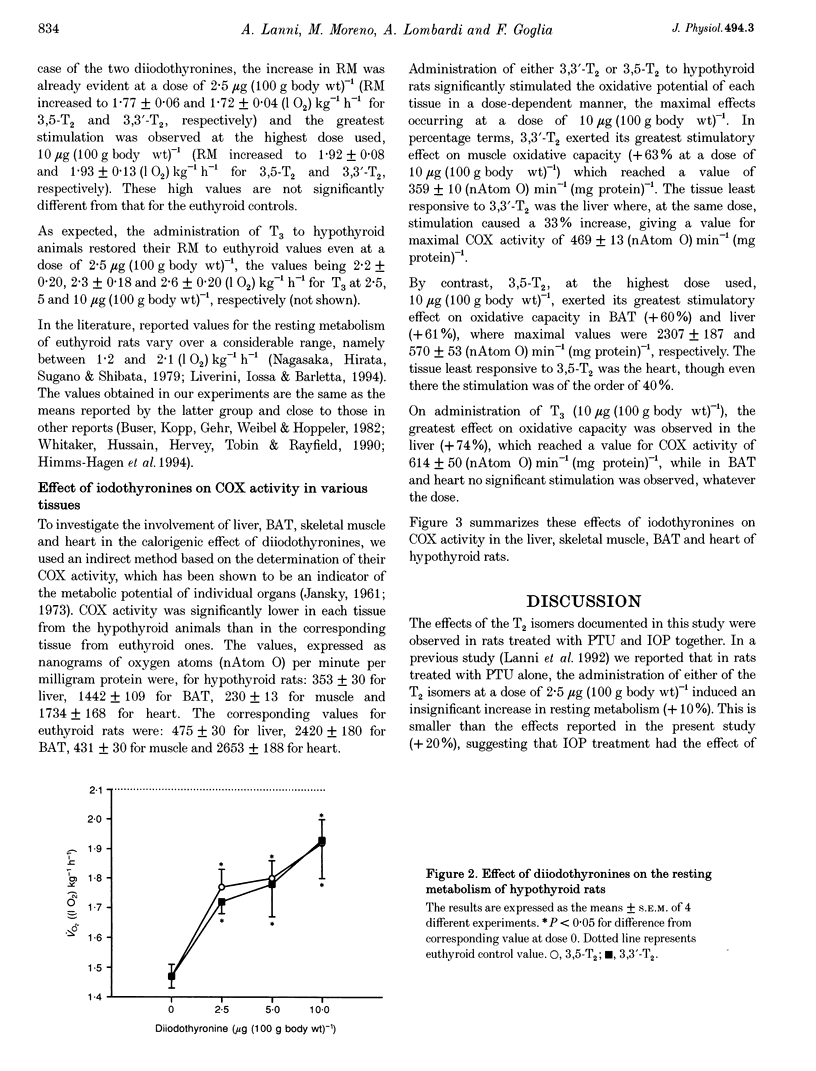
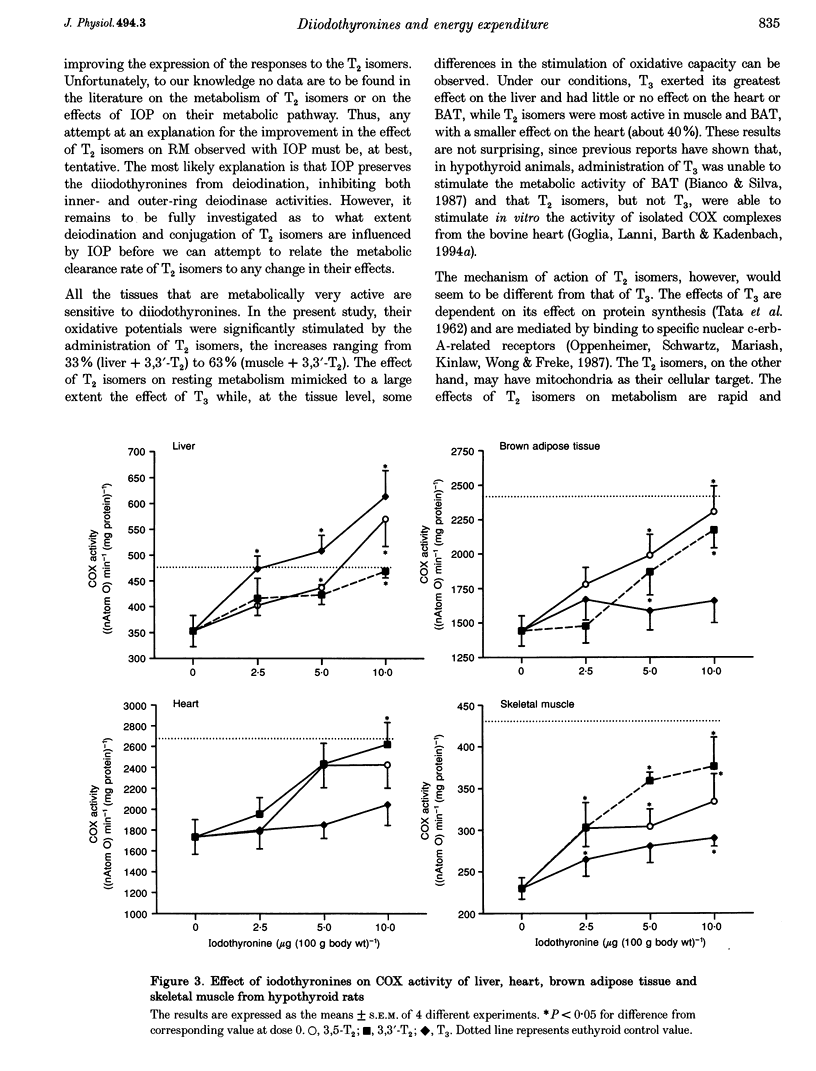

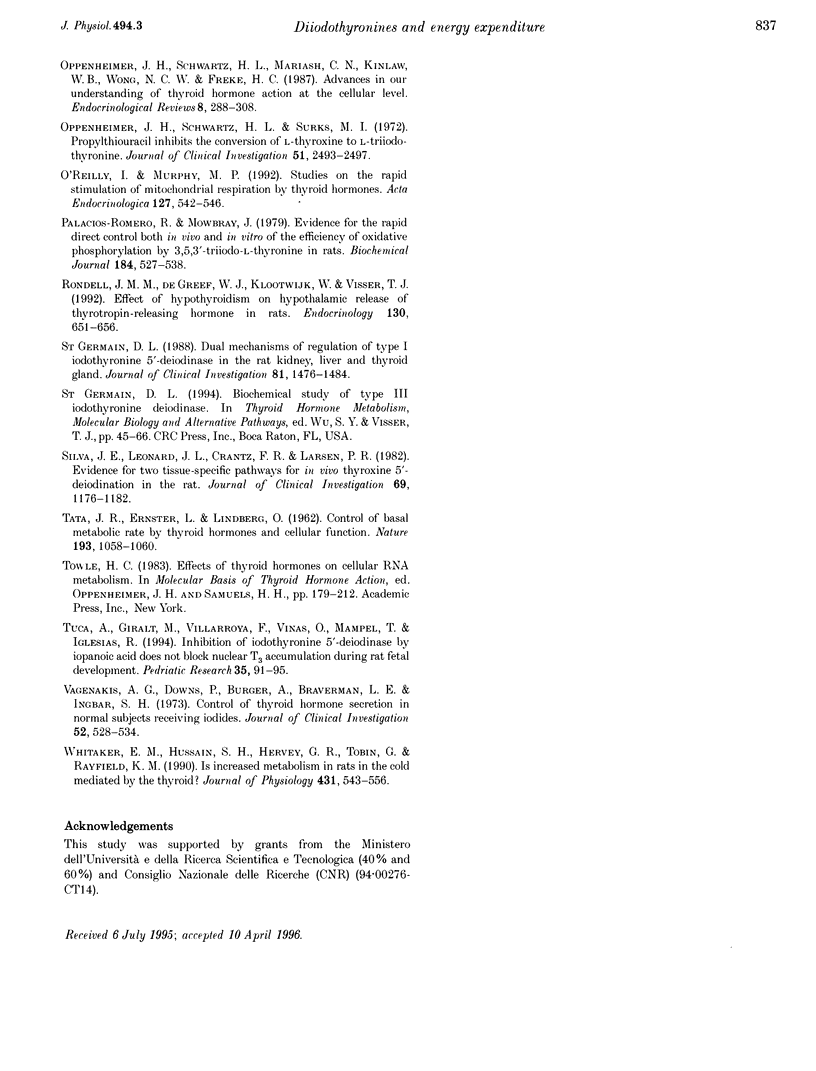
Selected References
These references are in PubMed. This may not be the complete list of references from this article.
- Acheson K. J., Burger A. G. A study of the relationship between thermogenesis and thyroid hormones. J Clin Endocrinol Metab. 1980 Jul;51(1):84–89. doi: 10.1210/jcem-51-1-84. [DOI] [PubMed] [Google Scholar]
- Barré H., Bailly L., Rouanet J. L. Increased oxidative capacity in skeletal muscles from cold-acclimated ducklings: a comparison with rats. Comp Biochem Physiol B. 1987;88(2):519–522. doi: 10.1016/0305-0491(87)90337-3. [DOI] [PubMed] [Google Scholar]
- Bianco A. C., Silva J. E. Optimal response of key enzymes and uncoupling protein to cold in BAT depends on local T3 generation. Am J Physiol. 1987 Sep;253(3 Pt 1):E255–E263. doi: 10.1152/ajpendo.1987.253.3.E255. [DOI] [PubMed] [Google Scholar]
- Blake H. H., Henning S. J. Effect of propylthiouracil dose on serum thyroxine, growth, and weaning in young rats. Am J Physiol. 1985 May;248(5 Pt 2):R524–R530. doi: 10.1152/ajpregu.1985.248.5.R524. [DOI] [PubMed] [Google Scholar]
- Buser K. S., Kopp B., Gehr P., Weibel E. R., Hoppeler H. Effect of cold environment on skeletal muscle mitochondria in growing rats. Cell Tissue Res. 1982;225(2):427–436. doi: 10.1007/BF00214693. [DOI] [PubMed] [Google Scholar]
- Bürgi H., Wimpfheimer C., Burger A., Zaunbauer W., Rösler H., Lemarchand-Béraud T. Changes of circulating thyroxine, triiodothyronine and reverse triiodothyronine after radiographic contrast agents. J Clin Endocrinol Metab. 1976 Dec;43(6):1203–1210. doi: 10.1210/jcem-43-6-1203. [DOI] [PubMed] [Google Scholar]
- Erickson V. J., Cavalieri R. R., Rosenberg L. L. Thyroxine-5'-deiodinase of rat thyroid, but not that of liver, is dependent on thyrotropin. Endocrinology. 1982 Aug;111(2):434–440. doi: 10.1210/endo-111-2-434. [DOI] [PubMed] [Google Scholar]
- Goglia F., Lanni A., Barth J., Kadenbach B. Interaction of diiodothyronines with isolated cytochrome c oxidase. FEBS Lett. 1994 Jun 13;346(2-3):295–298. doi: 10.1016/0014-5793(94)00476-5. [DOI] [PubMed] [Google Scholar]
- Goglia F., Lanni A., Horst C., Moreno M., Thoma R. In vitro binding of 3,5-di-iodo-L-thyronine to rat liver mitochondria. J Mol Endocrinol. 1994 Dec;13(3):275–282. doi: 10.1677/jme.0.0130275. [DOI] [PubMed] [Google Scholar]
- Himms-Hagen J., Cui J., Danforth E., Jr, Taatjes D. J., Lang S. S., Waters B. L., Claus T. H. Effect of CL-316,243, a thermogenic beta 3-agonist, on energy balance and brown and white adipose tissues in rats. Am J Physiol. 1994 Apr;266(4 Pt 2):R1371–R1382. doi: 10.1152/ajpregu.1994.266.4.R1371. [DOI] [PubMed] [Google Scholar]
- Horst C., Rokos H., Seitz H. J. Rapid stimulation of hepatic oxygen consumption by 3,5-di-iodo-L-thyronine. Biochem J. 1989 Aug 1;261(3):945–950. doi: 10.1042/bj2610945. [DOI] [PMC free article] [PubMed] [Google Scholar]
- JANSKY L. Total cytochrome oxidase activity and its relation to basal and maximal metabolism. Nature. 1961 Mar 18;189:921–922. doi: 10.1038/189921a0. [DOI] [PubMed] [Google Scholar]
- Janský L. Non-shivering thermogenesis and its thermoregulatory significance. Biol Rev Camb Philos Soc. 1973 Feb;48(1):85–132. doi: 10.1111/j.1469-185x.1973.tb01115.x. [DOI] [PubMed] [Google Scholar]
- Kaplan M. M., Utiger R. D. Iodothyronine metabolism in rat liver homogenates. J Clin Invest. 1978 Feb;61(2):459–471. doi: 10.1172/JCI108957. [DOI] [PMC free article] [PubMed] [Google Scholar]
- Katyare S. S., Bangur C. S., Howland J. L. Is respiratory activity in the brain mitochondria responsive to thyroid hormone action?: a critical re-evaluation. Biochem J. 1994 Sep 15;302(Pt 3):857–860. doi: 10.1042/bj3020857. [DOI] [PMC free article] [PubMed] [Google Scholar]
- Köhrle J. Thyroid hormone deiodination in target tissues--a regulatory role for the trace element selenium? Exp Clin Endocrinol. 1994;102(2):63–89. doi: 10.1055/s-0029-1211267. [DOI] [PubMed] [Google Scholar]
- Lanni A., Moreno M., Cioffi M., Goglia F. Effect of 3,3'-diiodothyronine and 3,5-diiodothyronine on rat liver oxidative capacity. Mol Cell Endocrinol. 1992 Aug;86(3):143–148. doi: 10.1016/0303-7207(92)90138-v. [DOI] [PubMed] [Google Scholar]
- Lanni A., Moreno M., Horst C., Lombardi A., Goglia F. Specific binding sites for 3,3'-diiodo-L-thyronine (3,3'-T2) in rat liver mitochondria. FEBS Lett. 1994 Sep 5;351(2):237–240. doi: 10.1016/0014-5793(94)00840-x. [DOI] [PubMed] [Google Scholar]
- Lanni A., Moreno M., Lombardi A., Goglia F. Rapid stimulation in vitro of rat liver cytochrome oxidase activity by 3,5-diiodo-L-thyronine and by 3,3'-diiodo-L-thyronine. Mol Cell Endocrinol. 1994 Feb;99(1):89–94. doi: 10.1016/0303-7207(94)90150-3. [DOI] [PubMed] [Google Scholar]
- Nagasaka T., Hirata K., Sugano Y., Shibata H. Heat balance during physical restraint in rats. Jpn J Physiol. 1979;29(4):383–392. doi: 10.2170/jjphysiol.29.383. [DOI] [PubMed] [Google Scholar]
- O'Reilly I., Murphy M. P. Studies on the rapid stimulation of mitochondrial respiration by thyroid hormones. Acta Endocrinol (Copenh) 1992 Dec;127(6):542–546. doi: 10.1530/acta.0.1270542. [DOI] [PubMed] [Google Scholar]
- Obregon M. J., Pascual A., Mallol J., Morreale de Escobar G., Escobar del Rey F. Evidence against a major role of L-thyroxine at the pituitary level: studies in rats treated with iopanoic acid (telepaque). Endocrinology. 1980 Jun;106(6):1827–1836. doi: 10.1210/endo-106-6-1827. [DOI] [PubMed] [Google Scholar]
- Oppenheimer J. H., Schwartz H. L., Mariash C. N., Kinlaw W. B., Wong N. C., Freake H. C. Advances in our understanding of thyroid hormone action at the cellular level. Endocr Rev. 1987 Aug;8(3):288–308. doi: 10.1210/edrv-8-3-288. [DOI] [PubMed] [Google Scholar]
- Oppenheimer J. H., Schwartz H. L., Surks M. I. Propylthiouracil inhibits the conversion of L-thyroxine to L-triiodothyronine. An explanation of the antithyroxine effect of propylthiouracil and evidence supporting the concept that triiodothyronine is the active thyroid hormone. J Clin Invest. 1972 Sep;51(9):2493–2497. doi: 10.1172/JCI107063. [DOI] [PMC free article] [PubMed] [Google Scholar]
- Palacios-Romero R., Mowbray J. Evidence for the rapid direct control both in vivo and in vitro of the efficiency of oxidative phosphorylation by 3,5,3'-tri-iodo-L-thyronine in rats. Biochem J. 1979 Dec 15;184(3):527–538. doi: 10.1042/bj1840527. [DOI] [PMC free article] [PubMed] [Google Scholar]
- Rondeel J. M., de Greef W. J., Klootwijk W., Visser T. J. Effects of hypothyroidism on hypothalamic release of thyrotropin-releasing hormone in rats. Endocrinology. 1992 Feb;130(2):651–656. doi: 10.1210/endo.130.2.1733713. [DOI] [PubMed] [Google Scholar]
- Silva J. E., Leonard J. L., Crantz F. R., Larsen P. R. Evidence for two tissue-specific pathways for in vivo thyroxine 5'-deiodination in the rat. J Clin Invest. 1982 May;69(5):1176–1184. doi: 10.1172/JCI110554. [DOI] [PMC free article] [PubMed] [Google Scholar]
- St Germain D. L. Dual mechanisms of regulation of type I iodothyronine 5'-deiodinase in the rat kidney, liver, and thyroid gland. Implications for the treatment of hyperthyroidism with radiographic contrast agents. J Clin Invest. 1988 May;81(5):1476–1484. doi: 10.1172/JCI113479. [DOI] [PMC free article] [PubMed] [Google Scholar]
- TATA J. R., ERNSTER L., LINDBERG O. Control of basal metabolic rate by thyroid hormones and cellular function. Nature. 1962 Mar 17;193:1058–1060. doi: 10.1038/1931058a0. [DOI] [PubMed] [Google Scholar]
- Tuca A., Giralt M., Villarroya F., Viñas O., Mampel T., Iglesias R. Inhibition of iodothyronine 5'-deiodinase by iopanoic acid does not block nuclear T3 accumulation during rat fetal development. Pediatr Res. 1994 Jan;35(1):91–95. doi: 10.1203/00006450-199401000-00019. [DOI] [PubMed] [Google Scholar]
- Vagenakis A. G., Downs P., Braverman L. E., Burger A., Ingbar S. H. Control of thyroid hormone secretion in normal subjects receiving iodides. J Clin Invest. 1973 Feb;52(2):528–532. doi: 10.1172/JCI107212. [DOI] [PMC free article] [PubMed] [Google Scholar]
- Whitaker E. M., Hussain S. H., Hervey G. R., Tobin G., Rayfield K. M. Is increased metabolism in rats in the cold mediated by the thyroid? J Physiol. 1990 Dec;431:543–556. doi: 10.1113/jphysiol.1990.sp018346. [DOI] [PMC free article] [PubMed] [Google Scholar]


